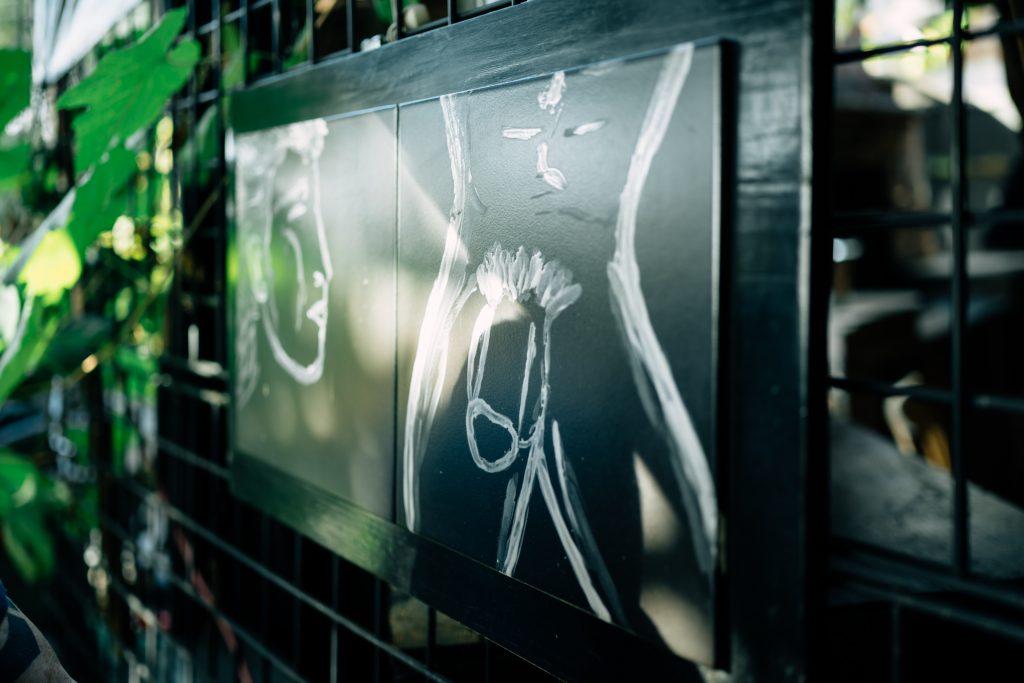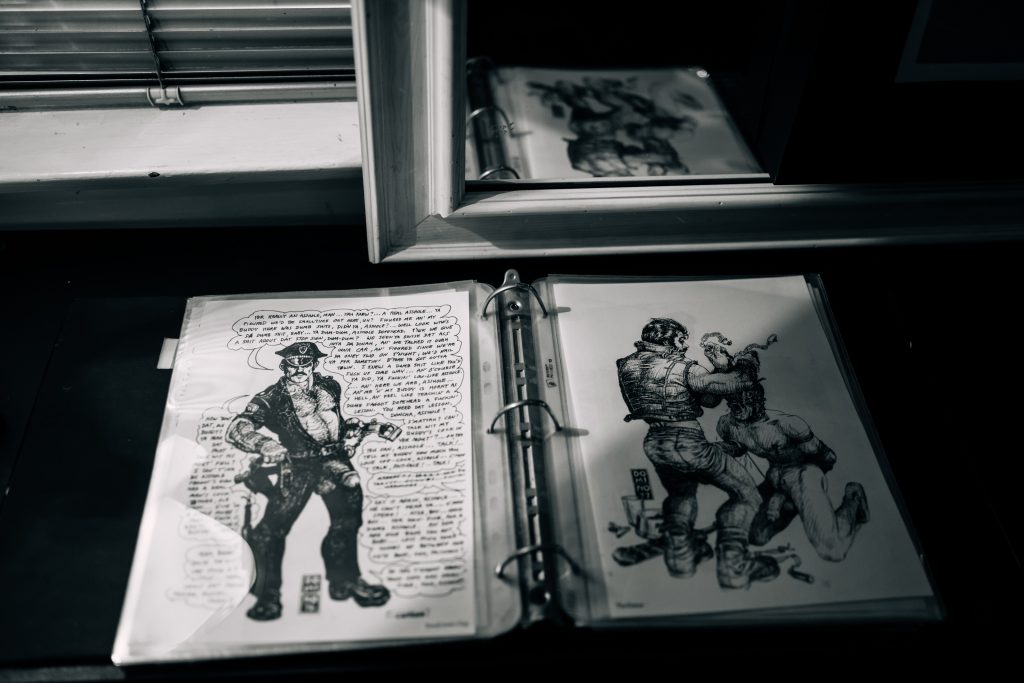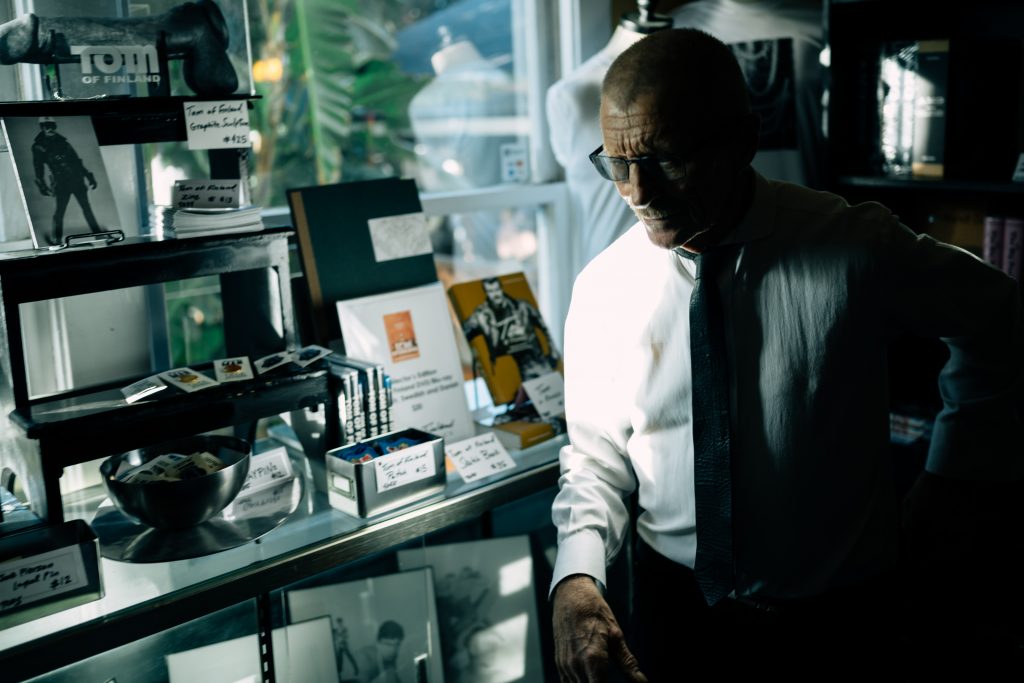Tom of Finland’s Centenary, Seen Through The Artist’s Home, Foundation + Collaborations
Reverberations from the life of the “gay Norman Rockwell”

Born 8 May 1920, homoerotic artist Tom of Finland had a multi-decade career that did not end with his passing in 1991. The legacy of Tom, born Touko Valio Laaksonen, continues to influence emerging artists and inspire members of the queer community. Tom House in LA’s Echo Park is still the center of the expanding universe that surrounds the artist and his work. The Tom of Finland Foundation maintains the home, archives and significant art collection, where Tom’s work not only lives on but also finds new life, resonating and inspiring new generations and audiences. This September saw the release of Tom of Finland: The Official Life and Work of a Gay Hero—and we’ve personally fallen in love with everything from Flavor Paper’s Tom of Finland wallpaper to CDLP’s Tom of Finland Centennial jock strap (which debuted two years ago as a limited edition release). These collaborations matter because Tom is an artist who represents freedom—freedom of expression and sexuality. And this “gay Norman Rockwell” not only tore down barriers but brought other artists up with him.

Built in 1910, the Tom House is now registered as a historic cultural landmark in Los Angeles. As one would expect, it’s filled with Tom’s work (nearly 2,500 pieces) and thousands of works from other (mostly queer) artists that he collected or whose work was left to the foundation when another suitable home wasn’t available. Penises, of course, are everywhere. A lover of Tom’s, and often his muse, Durk Dehner bought the home in 1979. He still lives there today—along with several people involved in the foundation, which has operated from the home since ’84. Tom spent the last 10 years of his life living there, too, and his room is as he left it.

Dehner says that he felt it was his mission to fulfill Tom’s dreams. Today, that includes “presenting a healthy perspective on art that is about sexuality,” and today the home has one of the world’s largest collections. The collection continues to grow as Dehner says, “We are continuing to bring in work of new artists and believe it is our job to validate and empower.” In fact, they also house an artist in residence (which has included My Gay Eye creator Rinaldo Hopf).

In ’76, Dehner and Tom were introduced by another artist through the mail—after the former saw some of Tom’s art in Spike, a popular leather bar in NYC. When Dehner realized that Tom didn’t have any representation and that he had been prolifically pirated over the years, they established the Tom of Finland Company in the US together in ’79 to protect Tom’s previous titles and allow him to create new titles freely. It put many of the pirates out of business.

“Tom was able to take on commissions and sell original artwork,” Dehner says, but they realized they needed a non-profit entity to house his artwork, ephemera collections, uniforms and correspondence. Thus, the non-profit Tom of Finland Foundation was formed in ’84. They quickly became membership-supported and volunteer-driven—and its role expanded.
I know my little ‘dirty drawings’ are never going to hang in the main salons of the Louvre but it would be nice if—I would like to say ‘when,’ but I better say ‘if’—our world learns to accept all the different ways of loving. Then maybe I could have a place in one of the smaller side rooms.
-Tom of Finland, February 1991
“The original idea was that it was an archive for Tom,” Dehner says. “But there was another kind of crises in 1984. There were several thousands of cases of HIV in the country and parents didn’t want their offsprings’ belongings. While there were no museums or institutions that would accept Tom’s work, we had to become a safe repository for all things erotic. We became the place that people could leave their things.” The Tom House would receive calls from roommates and lovers asking them to preserve erotica.

Walking the hallways of the Tom House, one cannot help but feel Tom’s relationship with the art world—be that his influence, mentorship or companionship. Works from the Haas Brothers and Pansy Ass Ceramics can be found within. There’s even work by Robert Mapplethorpe, the result of an art exchange the photographer did with Tom.

“Artists have always wanted to have a piece of his art for what he represents,” Dehner tells us. Some peers even ushered in his place in institutional art. In fact, artist Mike Kelley invited Tom to do a lecture series while he was teaching at Cal Arts. It was the first time Tom found himself in an academic setting discussing his work.

At the foundation, installations are typically changed every two to three months. This varies between permanent collection items and exhibitions like last year’s riveting group show, Secret Gay Box. Beyond the exhibits, the home has binders full of artist submissions, tear sheets and magazines from every artist who’s ever done anything erotic (not to mention 500 pages of reference binders of Tom’s work).

Tom’s artistic process was a blend of fantasy and reality. He would take a photograph of a model, then develop the film himself. He would make a print, then cut it out. Then he would put it on the appropriate place in reference binders. As he drew, the vision veered from expectation.

“Tom actually made his men homosexual,” Dehner says. “They had a gaze between. We knew they were gay. They weren’t just beefcakes.” This was important to the viewer because, “He could embed things in the drawing. He could communicate so that queer guys could understand it.” He also provided substantial insight into gay culture at the time.

“He wanted to see if he could make a difference in how gays felt about themselves,” Dehner adds. “In the 1950s it was hard for him to find queer people who had strong self-esteem. He had strong self-esteem because his parents brought him up to have self-respect.”

“It’s a phenomenon, you know,” Dehner says. “Not that he brings riches, but he brings happiness; you see a smile on people’s faces when they look at his work.” This reaction has led to Tom of Finland art finding itself in unexpected places. An increased interest in licensing happened in Finland and everywhere else as Tom became a cultural icon—as opposed to a gay icon.

“Our friends in Finland said you really should apply for a postage stamp and we said, ‘Oh yeah, like they’re going to accept it.’ Well, we did the application process and they did accept it,” Dehner explains. “It took about a year for the design process, and then production for about a year. 158 different countries pre-ordered the stamps. It broke records and crashed their website.” To this day, Tom of Finland stamps are sought out by collectors.

Another authentic collaboration came together with Swedish essentials brand CDLP. The foundation found alignment with the brand and its different take on masculinity. They also appreciated that CDLP was a Nordic neighbor. They approached the brand with the concept to “let Tom design the underwear” in the CDLP language. Founders Christian Larson and Andreas Palm selected a drawing that would act as inspiration for a limited edition jock strap that was so successful it’s been released again, along with a tank top.

Another stand out from the many licensed Tom of Finland products is the recently released wallpaper by Brooklyn-based Flavor Paper, available in tame and XXX versions in a variety of styles. Two years in the making, it is certain to perk up any room you place it in.

It all goes back to the artist, of course—a dedicated visionary. “He could pick up an instrument and pretty much it wouldn’t take long and he could play it. He could hear songs on the on the radio and then go and play them,” Dehner remembers. “But he came to a critical place and realized if he was really going to go above his job—this job that he had made himself—he was going to have to make art his priority.”

The foundation’s work is broader in scope. “It’s really about getting the house utilized,” Dehner says. In pre-COVID times, they had “drawing classes and tea ceremonies. We had an art and culture weekend here. The foundation has found its audience again and again. Year after year.” Dehner says he’s been worried in the past that interest would die, but ultimately all the new generations of fans needed “was to be invited.”

“He probably could not ever be in the main salons of the Louvre,” Dehner says, emulating a quote Tom made in 1991 that’s on display at the home—but noting that Tom did live to learn of his retrospective at The Whitney that same year. “But maybe if, or when, gays are given permission to love the same way,” Dehner concludes, “maybe you could find him in a little side room there.” Until that time, Tom of Finland can be found in many other meaningful places.
Hero image by Josh Rubin












